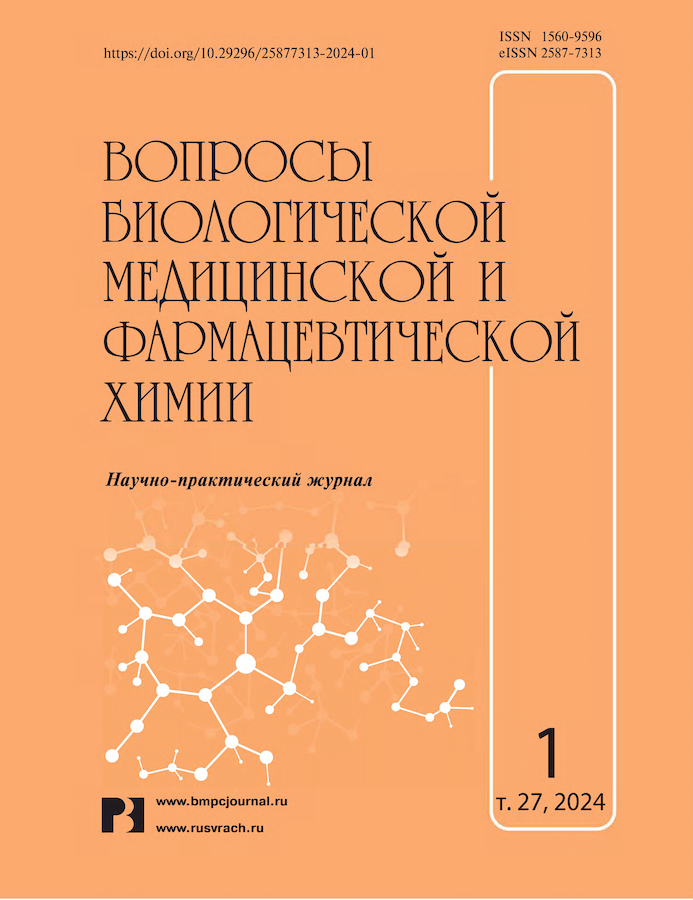Application of selective hypromellose sorbent for the benzocaine quantitation in pharmaceutical formulations
- Authors: Kachalkin М.N.1, Voronin A.V.1
-
Affiliations:
- Samara State Medical University of the Ministry of Healthcare of the Russian Federation
- Issue: Vol 27, No 1 (2024)
- Pages: 40-46
- Section: Pharmaceutical chemistry
- URL: https://journals.eco-vector.com/1560-9596/article/view/625791
- DOI: https://doi.org/10.29296/25877313-2024-01-05
- ID: 625791
Cite item
Abstract
Introduction. In quality control of pharmaceutical formulations, there are methodological approaches based on the preliminary separation of sample components and approaches without preliminary separation. The use of solid-phase extraction (SPE) allows to separate analytes during sample preparation, with the separation selectivity determining the analysis selectivity as a whole. Currently, sorbents that provide selectivity in interaction with the analyte are of interest.
Aim. Evaluation of the metrological characteristics of benzocaine quantitation by UV-spectrophotometry in certain pharmaceutical formulations using hypromellose sorbent for solid-phase extraction.
Material and methods. The sorbent using a method developed by us was obtained. Benzocaine (FS.2.1.0634, Russia State Pharmacopoeia XV ed.) to form active binding sites in sorbent structure was applied. The sorbent structure is polycyanoacrylate matrix with hypromellose fragments, the surface area is 255.50 m2/g, pore volume is 0.1433 cm3, pore diameter is 5.32 nm. The sorption capacity of hypromellose sorbent for benzocaine was 12.2±0.8 μg/g. The SPE technique is proposed. SPE includes the stages: conditioning, sample addition and step-by-step elution with purified water and hydrochloric acid solution 0.1 mol/L. The spectrophotometer SF-56 was used to measure the absorbance at an analytical wavelength of 286 nm. To evaluate the selectivity (specificity) of sample preparation during chromatographic (SPE) separation of pharmaceutical formulations, absorption spectra of eluates in the wavelength range of 200-400 nm were scanned. The benzocaine identification in the eluate was carried out based on absorption peaks at 220 and 286 nm. The benzocaine calibration curve in the range of 1-20 μg/ml. To determination the metrological characteristics of benzocaine quantitation method, 11 parallel determinations of samples of each pharmaceutical formulation were made.
Results. When realizing the benzocaine quantitation technique for measuring absorbance, it is advisable to use only the first portions of eluate (a solution of hydrochloric acid) in a volume of 5-10 ml were obtained. The relative error of benzocaine average concentration in the pharmaceutical formulations ranged from 1.28 to 1.34% for technique that included the SPE stage, and from 1.86 to 2.02% for technique that did not include it. A comparison of the modifications of the spectrophotometric quantitation of benzocaine in pharmaceutical formulation using hypromellose sorbent and technique without the SPE did not reveal a statistically significant difference in reproducibility. For the modification technique without SPE, an increase of benzocaine concentration and in determination relative error by an average of 48.0% were observed.
Conclusion. The possibility of using a selective hypromellose sorbent for sample preparation for benzocaine quantitation determination in pharmaceutical formulations has been showed. The use of a sorbent for SPE at the sample preparation stage reduces the systematic error of benzocaine spectrophotometry quantitation for the analyzed pharmaceutical formulations by an average of 79.2%.
Full Text
About the authors
М. N. Kachalkin
Samara State Medical University of the Ministry of Healthcare of the Russian Federation
Author for correspondence.
Email: m.n.kachalkin@samsmu.ru
Post-graduate Student
Russian Federation, SamaraA. V. Voronin
Samara State Medical University of the Ministry of Healthcare of the Russian Federation
Email: m.n.kachalkin@samsmu.ru
Dr.Sc. (Pharm.), Associate Professor
Russian Federation, SamaraReferences
- Moffat A.C., Osselton M.D., Widdop B., Watts J. Clarke's Analysis of Drugs and Poisons. 4th ed. London, 2011.
- Wu J.H., He C.Y. Advances in Cellulose-Based Sorbents for Extraction of Pollutants in Environmental Samples. Chromato-graphia, 2019; 82, 1151–1169; https://doi.org/10.1007/s10337-019-03708-x.
- Качалкин М.Н., Воронин А.В. Получение сорбентов для твердофазной экстракции бензойной кислоты из водных растворов. Аспирантский вестник Поволжья. 2023; 23(1): 36–40. [Kachalkin М.N., Voronin A.V. Preparation of sorbents for solid-phase extraction of benzoic acid from aqueous solutions. Aspirantskiy vestnik Povolzhiya. 2023;23(1):36–40. (In Russ.)]. doi: 10.55531/2072-2354.2023.23.1.36-40.
- Качалкин М.Н., Воронин А.В. Получение сорбентов для твердофазной экстракции салициловой кислоты из водных растворов. Аспирантский вестник Поволжья. 2021;5–6:16–22. [Kachalkin М.N., Voronin A.V. Preparation of sorbents for solid-phase extraction of salicylic acid from aqueous solutions. Aspirantskiy vestnik Povolzhiya. 2021;5–6:16–22. (In Russ.)]. doi: 10.55531/2072-2354.2021.21.3.16-22.
- РЛС® – Регистр лекарственных средств России® [RMR – Register of Medicines of Russia. (In Russ.).]. Доступно по: https://www.rlsnet.ru (September 20, 2023).
- Качалкин М.Н. Патент РФ на изобретение RU 2765188 C1/ 26.01.2022. Бюл. № 3. Способ получения селективного сорбента для твердофазной экстракции. [Kachalkin M.N. Patent RU 2765188 C1/ 26.01.2022. Byul. № 3. Method for producing a selective sorbent for solid-phase extraction. (In Russ).] Доступно по: https://elibrary.ru/download/elibrary_47796037_29577309.PDF. Ссылка активна на 20.09.2023.
- Hanan A.M. Simple spectrophotometric methods for the simultaneous determination of antipyrine and benzocaine. Bulletin of Faculty of Pharmacy, Cairo University; 54, 2, 2016, 181-189. DOI: https://doi.org/10.1016/j.bfopcu.2016.05.003.
- ОФС.1.1.1.0013 Статистическая обработка результатов физических, физико-химических и химических испытаний. XV изд. Т. 1. М., 2023. [General Pharmacopeial Article ОФС.1.1.1.0013 "Statistical processing of results of physical, physicochemical, and chemical tests". State Pharmacopoeia of the Russian Federation (In Russ).].








